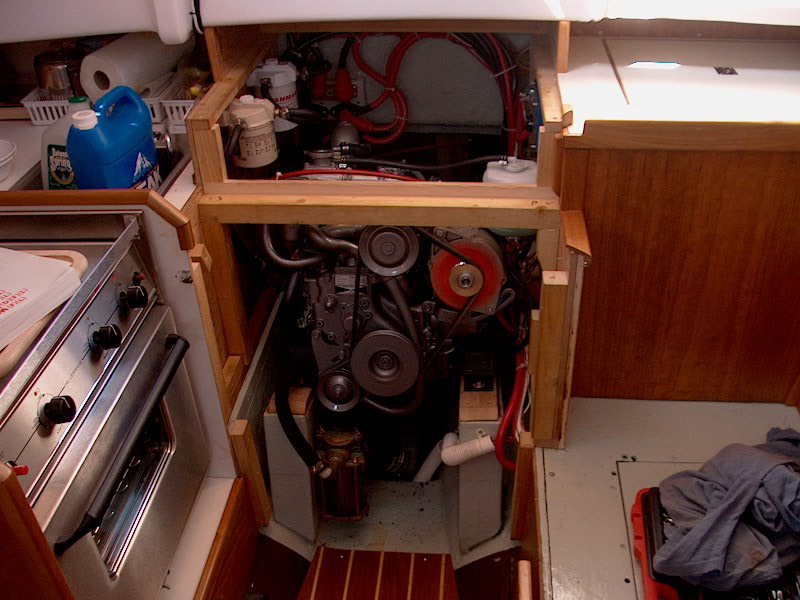|
 As of Thursday, 8/2/01, Glissando is
relaunched, and the new engine runs! After bleeding the fuel system, it
started right up with no effort whatsoever. You can tell it's running in
the picture below because the alternator blades are an orange blur--compare with
other pictures on the site! We ran it for a couple hours Thursday night,
and it's wonderful. Smooth, quiet, powerful...it's so much better than the
old stinker I can't even express it properly. I think we appreciate it all
the more because of what we had to deal with before.
As of Thursday, 8/2/01, Glissando is
relaunched, and the new engine runs! After bleeding the fuel system, it
started right up with no effort whatsoever. You can tell it's running in
the picture below because the alternator blades are an orange blur--compare with
other pictures on the site! We ran it for a couple hours Thursday night,
and it's wonderful. Smooth, quiet, powerful...it's so much better than the
old stinker I can't even express it properly. I think we appreciate it all
the more because of what we had to deal with before.
|
|
THURSDAY 8/2/01
I had been planning on relaunching Friday
morning, but progress was so good that, when I was asked by the yard if I wanted
to go in on Thursday afternoon, I jumped at the chance. I wasn't quite
ready to start the engine--I still had to add coolant and bleed the fuel system,
as well as make all my final checks of everything--but they towed me back out to
the mooring right after launching, so I could finish up at my leisure.
Once on the mooring, I filled up the coolant
recovery tank and heat exchanger with a 50/50 mix of antifreeze and water.
I checked all the fluids one last time--the engine was shipped with oil in the
crankcase and transmission--and looked over all my connections, checking clamps,
wires, etc. Then, I began bleeding the new fuel system. Using the
built-in pump on the Racor filters, I filled both filters with fuel (the
old one already had fuel in it) and began priming the system. I'd pump and
pump, then twist the bleed screw on the engine-mounted fuel filter to release
air. This took a little while, but soon I had clear fuel running
out. Then, I moved on to the fuel return fittings on the injectors--the
next place to bleed, and what was recommended by the manual. After a
couple go-rounds, I decided to try the engine. It jumped right to life
with no protesting at all, surprising me a little--I hadn't though I was through
with bleeding. The new engine pumps a lot of water though the exhaust,
making the exhaust note barely noticeable--all you really hear is the splash of
water as it exits. It is so much quieter than the old exhaust, which
always sounded horrible. The engine is much quieter--wait till I get my
soundproofing in place--and doesn't transmit any vibration to the boat, although
it does shake on its rubber mounts.
Following the prescribed break-in procedure, I
ran the engine at a low idle for a few minutes--about 1200 RPM--and then
throttled up a bit to around 1600 RPM and let it run for a while. I
had to call my wife and hold the phone up to the engine so she'd know that it
ran! I let the engine come up to temperature, and then tested the gear
operation. Later on in the evening, we took the boat out for a motor
cruise--despite being a great evening for sailing, we were overjoyed to be
powering. It was smooth and quiet, and easily pushed the boat along.
Cruising speed seems to be around 2500-2600 RPM? WOT is around 3500, and
the boat flies.
We just returned from a four-day cruise, and,
most unfortunately, had to power the entire time--no wind! This was a
great chance to get acquainted with the new engine, however, and to test it
under a variety of circumstances. Follow the link below for some notes and
reports on the performance of the engine during this cruise.
Report on
Engine Performance to Date
|